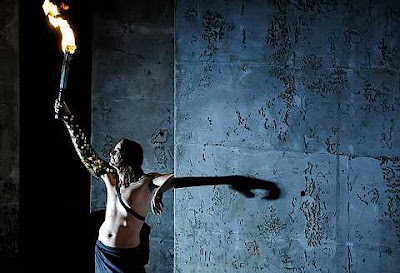
A general view of the archaeological site where a Thracian mound was found near the village of Borisovo, some 360 km (223 miles) east from the capital Sofia, August 7, 2008. A team of archaeologists led by Bulgarian archaeologist Daniela Agre found fully preserved chariot in the mound, dated back to the 2nd century A.D. Not much history has survived of the Thracians, who some experts say settled on what is now Bulgaria, Romania, northern Greece and Turkey's European territory from as early as 4 000 B.C. until they were finally incorporated into the Roman Empire in A.D. 46.


Members of an international religious movement called the White Brotherhood perform a ritual dance near Babreka lake, in Rila Mountain, 120 km (75 miles) south of Sofia, August 19, 2008, as part of celebration of their New Year. The teaching of the movement, whose founder is Bulgarian Peter Danov, is a synthesis of Christianity and Hinduism with a heavy emphasis on brotherly love, a healthy diet and living in harmony with nature. Picture taken August 19, 2008.

Bulgarian archaeologist Diana Dimitrova shows a golden ring encrusted with an unidentified gem and bearing an image of a musician, found at a Thracian mound near the village of Krushare, some 300 km (186 miles) east from the capital Sofia, August 16, 2008. A team of archaeologists led by Georgi Kitov found a golden pectoral necklace, golden ring, military artifacts and pottery in the mound, dated back to the fifth-fourth century B.C. Not much history has survived of the Thracians, who some experts say settled on what is now Bulgaria, Romania, northern Greece and Turkey's European territory from as early as 4 000 B.C. until they were finally incorporated into the Roman Empire in A.D. 46.


A golden pectoral necklace found at a Thracian mound is pictured near the village of Krushare, some 300 km (186 miles) east from the capital Sofia, August 16, 2008. A team of archaeologists led by Georgi Kitov found a golden pectoral necklace, golden ring, military artifacts and pottery in the mound, dated back to the fifth-fourth century B.C. Not much history has survived of the Thracians, who some experts say settled on what is now Bulgaria, Romania, northern Greece and Turkey's European territory from as early as 4 000 B.C. until they were finally incorporated into the Roman Empire in A.D. 46.

A member of an international religious movement called the White Brotherhood performs a ritual dance near Babreka lake, in Rila Mountain, 120 km (75 miles) south of Sofia, August 19, 2008, as part of celebration of their New Year. The teaching of the movement, whose founder is Bulgarian Peter Danov, is a synthesis of Christianity and Hinduism with a heavy emphasis on brotherly love, a healthy diet and living in harmony with nature. Picture taken August 19, 2008.




Members of an international religious movement called the White Brotherhood perform a ritual dance near Babreka lake, in Rila Mountain, 120 km (75 miles) south of Sofia, August 19, 2008, as part of celebration of their New Year. The teaching of the movement, whose founder is Bulgarian Peter Danov, is a synthesis of Christianity and Hinduism with a heavy emphasis on brotherly love, a healthy diet and living in harmony with nature. Picture taken August 19, 2008.

















































1)
2)
3)
4)
5)
6)
7)
8)
9)
10)
11)
12)
13)
14)
15)



1)






